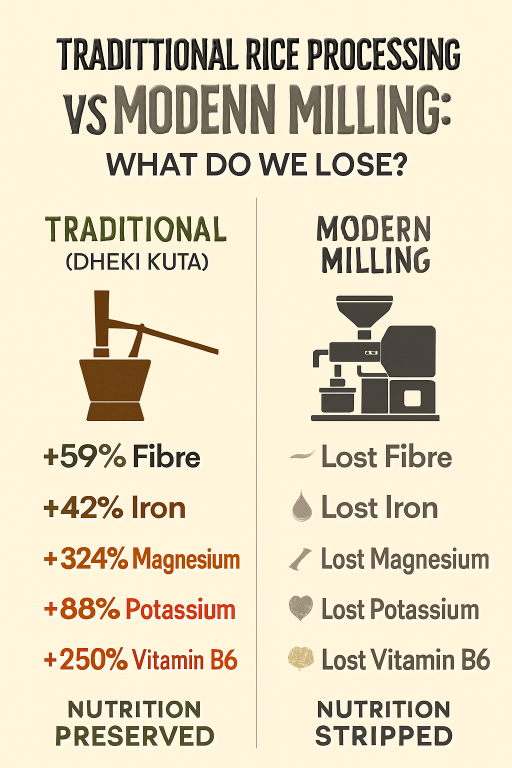More Than Just Rice
Rice is not just a staple in India — it is woven into our cultural, spiritual, and nutritional fabric. For centuries, families across rural India prepared rice through the Dheki Kuta (wood-pounding) method. This slow, cold, household-based practice preserved nutrients, built community, and connected people to their food.
But over the past few decades, this practice has disappeared, replaced by mechanized rice mills that prioritize whiteness, speed, and yield. What seems like an innocent shift has in fact created a nutritional crisis. Calories remain abundant, but essential micronutrients — iron, magnesium, potassium, B vitamins, fibre — have quietly vanished.
This is not just about nostalgia. The loss of traditional processing has worsened public health outcomes, contributed to hidden hunger, and increased risks of diabetes and heart disease.
The Cultural and Historical Role of the Dheki
The Dheki (or Dhenki, Okhli, Ural, depending on region) was once a fixture in every village home. Made of wood, it worked like a seesaw: one side was pressed by foot, the other side pounded the paddy placed in a mortar.
- In Bengal, the Dhenki was a symbol of village life, even appearing in folklore and literature.
- In Chhattisgarh, Odisha, and Jharkhand, women gathered to pound rice together, singing traditional songs in rhythm with the Dheki’s thud.
- In South India, similar tools (Ural, Ulakkai) were used for rice and spices, forming part of household kitchens.
The process was manual, rhythmic, and communal. More importantly, it was nutritionally protective: removing only the inedible husk, while leaving fibre-rich bran and micronutrient-rich layers intact.
What Modern Milling Changed
With the rise of industrial mills in the mid-20th century, rice processing shifted dramatically. Mills polished rice to make it whiter and softer, which consumers equated with purity. The consequences were profound:
- Nutrient Stripping → The bran layer, rich in fibre, iron, zinc, magnesium, and B vitamins, was lost.
- Heat & Friction → High-speed polishing degraded heat-sensitive vitamins.
- Shelf-life vs Nutrition → Polished rice stored longer but carried fewer nutrients.
📖 Scientific Evidence:
- A study in the Journal of Food and Nutrition Sciences confirmed that hand-pounded/Dheki rice retained higher protein, fat, and fibre than milled rice (Food & Nutrition Journal, 2019).
- CGIAR research showed that as the degree of milling (DOM) increased, iron and zinc content dropped sharply (Pandey et al., 2014).
- Research comparing glycemic response found that hand-pounded rice led to slower blood sugar rise, beneficial for diabetes management (ResearchGate, 2021).
Public Health Impact of Losing Traditional Processing
1. Hidden Hunger
India faces a dual challenge: enough calories but not enough nutrients. This “hidden hunger” stems partly from polished staples.
- NFHS-5 reports that 57% of women and 67% of children in India are anemic.
- Polished rice, stripped of iron and B vitamins, contributes to this crisis.
2. Rising Diabetes
India is called the diabetes capital of the world, with over 101 million cases (ICMR, 2023). The dominance of polished rice with a high glycemic index is a key factor. Fibre-rich, slow-release rice could help reduce this burden.
3. Cardiovascular Health
Potassium and magnesium protect against hypertension. WHO highlights that insufficient intake of these minerals is a risk factor for heart disease (WHO, 2023). Polished rice removes both.
4. Gut Health Decline
The microbiome thrives on dietary fibre. Traditional rice supported gut bacteria, while polished rice does little for digestive health.
Case Study: Dheki Kuta Cold-Processed Javaphool Rice
To illustrate the difference, a laboratory comparison of Dheki Kuta cold-pounded Javaphool rice versus normally milled rice was conducted.
Findings:
- 59% more fibre → better digestion, diabetes-friendly.
- 42% more iron → prevents anemia, boosts energy.
- 324% more magnesium → stronger bones, better sleep, stress reduction.
- 88% more potassium → heart and kidney protection.
- 250% more Vitamin B6 → brain health, mood regulation, sleep cycles.
This mirrors international research showing how traditional processing preserves micronutrients. It proves that what looks like “the same grain of rice” can lead to radically different health outcomes depending on processing.
Socio-Economic Dimensions: Women and Food Sovereignty
Traditional rice pounding was women-led. Women managed the Dheki, decided processing levels, and ensured nutritional quality. The shift to industrial milling took this power away:
- Communities lost control over their staple food.
- Women’s economic role shrank as home-processing became obsolete.
- Food sovereignty weakened as households became dependent on centralized mills.
Reviving traditional methods restores not just nutrition but also agency and livelihoods.
Global Parallels
The issue is not unique to India. Around the world, the decline of heritage milling has led to similar concerns:
- In Japan, hand-pounded genmai (brown rice) is regaining popularity as a health food.
- In Europe/US, “stone-ground” flours and “heritage milling” are marketed as premium products.
- In Africa, loss of traditional processing of millet and sorghum has paralleled rising micronutrient deficiencies.
This shows that the challenge is global — and so is the opportunity.
️ The Way Forward
- Consumer Awareness
Educating people that whiter is not healthier is the first step. Visual campaigns (infographics comparing nutrient retention) can shift perception. - Policy Support
Governments can include hand-pounded rice in Public Distribution Systems (PDS), school meals, and nutrition programs to fight anemia and hidden hunger. - Entrepreneurship & SHGs
Community-led units like those run by tribal women’s SHGs can revive traditional processing while creating livelihoods. - Hybrid Approaches
Semi-mechanized versions of Dheki processing can balance efficiency with nutrition preservation.
Conclusion
The fading of traditional practices like Dheki Kuta rice pounding is more than cultural loss — it is nutritional erosion. Calories remain, but vital nutrients vanish. This fuels anemia, diabetes, cardiovascular disease, and digestive decline.
Reviving heritage methods is not backwardness — it is progress. It offers a way to fight hidden hunger, empower women, strengthen food sovereignty, and restore community pride.
Polished rice fills the stomach. Dheki rice nourishes the body, mind, and future.

